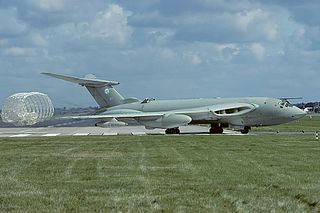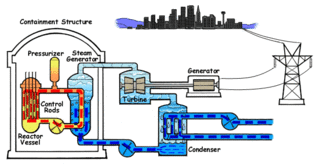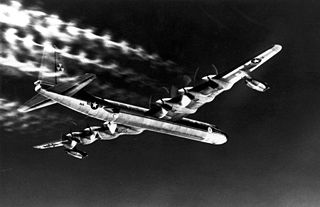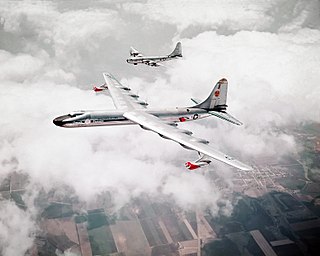Specifications (M-60)
| | This aircraft article is missing some (or all) of its specifications. If you have a source, you can help Wikipedia by adding them. |
The Myasishchev M-60 was a Soviet design for a nuclear-powered bomber. [1] The design was similar to the M-50 bomber prototype.
Myasishchev received the instruction to start the development of the M-60 on 19 May 1955. However, it did not make it out of the planning stage, and the M-60 program was cancelled in 1959. [1] [2]
It appears that the M-60 designation has been used for a number of projects at Myasishchev, [3] including a recent transport and civil aircraft. [4]
| | This aircraft article is missing some (or all) of its specifications. If you have a source, you can help Wikipedia by adding them. |
Aircraft of comparable role, configuration, and era

A strategic bomber is a medium- to long-range penetration bomber aircraft designed to drop large amounts of air-to-ground weaponry onto a distant target for the purposes of debilitating the enemy's capacity to wage war. Unlike tactical bombers, penetrators, fighter-bombers, and attack aircraft, which are used in air interdiction operations to attack enemy combatants and military equipment, strategic bombers are designed to fly into enemy territory to destroy strategic targets. In addition to strategic bombing, strategic bombers can be used for tactical missions. There are currently only three countries that operate strategic bombers: the United States, Russia and China.

The Handley Page Victor is a British jet-powered strategic bomber developed and produced by Handley Page during the Cold War. It was the third and final V bomber to be operated by the Royal Air Force (RAF), the other two being the Vickers Valiant and the Avro Vulcan. Entering service in 1958, the Victor was initially developed as part of the United Kingdom's airborne nuclear deterrent, but it was retired from the nuclear mission in 1968, following the discovery of fatigue cracks which had been exacerbated by the RAF's adoption of a low-altitude flight profile to avoid interception, and due to the pending introduction of the Royal Navy's submarine-launched Polaris missiles in 1969.

The Convair B-36 "Peacemaker" is a strategic bomber built by Convair and operated by the United States Air Force (USAF) from 1949 to 1959. The B-36 is the largest mass-produced piston-engined aircraft ever built, although it was exceeded in span and weight by the one-off Hughes Hercules. It has the longest wingspan of any combat aircraft. The B-36 was capable of intercontinental flight without refueling.

The Convair B-58 Hustler, designed and produced by American aircraft manufacturer Convair, was the first operational bomber capable of Mach 2 flight.

Nuclear propulsion includes a wide variety of propulsion methods that use some form of nuclear reaction as their primary power source. The idea of using nuclear material for propulsion dates back to the beginning of the 20th century. In 1903 it was hypothesized that radioactive material, radium, might be a suitable fuel for engines to propel cars, planes, and boats. H. G. Wells picked up this idea in his 1914 fiction work The World Set Free. Many aircraft carriers and submarines currently use uranium fueled nuclear reactors that can provide propulsion for long periods without refueling. There are also applications in the space sector with nuclear thermal and nuclear electric engines which could be more efficient than conventional rocket engines.

The Tupolev Tu-4 is a piston-engined Soviet strategic bomber that served the Soviet Air Force from the late 1940s to mid-1960s. The aircraft was a copy of the American Boeing B-29 Superfortress, having been reverse-engineered from seized aircraft that had made emergency landings in the USSR.

The Myasishchev M-4 Molot was a four-engined strategic bomber designed by Vladimir Mikhailovich Myasishchev and manufactured by the Soviet Union in the 1950s to provide a Long Range Aviation bomber capable of attacking targets in North America.

The North American XF-108 Rapier was a proposed long-range, high-speed interceptor aircraft designed by North American Aviation intended to defend the United States from supersonic Soviet strategic bombers. The aircraft would have cruised at speeds around Mach 3 with an unrefueled combat radius over 1,000 nautical miles, and was equipped with radar and missiles offering engagement ranges up to 100 miles (160 km) against bomber-sized targets.

The Convair X-6 was a proposed experimental aircraft project to develop and evaluate a nuclear-powered jet aircraft. The project was to use a Convair B-36 bomber as a testbed aircraft, and though one NB-36H was modified during the early stages of the project, the program was canceled before the actual X-6 and its nuclear reactor engines were completed. The X-6 was part of a larger series of programs, costing US$7 billion in all, that ran from 1946 through 1961. Because such an aircraft's range would not have been limited by liquid jet fuel, it was theorized that nuclear-powered strategic bombers would be able to stay airborne for weeks at a time.

The Tupolev Tu-95 is a large, four-engine turboprop-powered strategic bomber and missile platform. First flown in 1952, the Tu-95 entered service with the Long-Range Aviation of the Soviet Air Forces in 1956 and was first used in combat in 2015. It is expected to serve the Russian Aerospace Forces until at least 2040.
The Tupolev Tu-125 was an unrealized project to develop a new long-range supersonic bomber for the Soviet Air Force. Development commenced in 1958 to replace the newest Tu-22. The "Tu-125" designation was an internal one used by the Tupolev design bureau. Since the aircraft was never built, it never received a military designation.
V. M. Myasishchev Experimental Design Bureau or OKB-23, founded in 1951 by MGB UdSSR Vladimir Myasishchev, was one of the chief Soviet aerospace design bureaus until its dissolution in 1960. Vladimir Myasishchev went on to head TsAGI. In 1967, Myasishchev left TsAGI and recreated his bureau, which still exists to this day. The bureau prefix was "M." As of 2003, its workforce is estimated at approximately one thousand. Myasishchev and NPO Molniya intend to use the V-MT or M-55 as launch vehicle for sub-orbital spaceflight.

The Myasishchev M-50 is a Soviet prototype four-jet engine supersonic strategic bomber which never attained service. Only one flightworthy prototype was built, which was first flown in October 1959. The M-50 was constructed by the Myasishchev design bureau.

A nuclear-powered aircraft is a concept for an aircraft intended to be powered by nuclear energy. The intention was to produce a jet engine that would heat compressed air with heat from fission, instead of heat from burning fuel. During the Cold War, the United States and Soviet Union researched nuclear-powered bomber aircraft, the greater endurance of which could enhance nuclear deterrence, but neither country created any such operational aircraft.

The Tupolev Tu-95LAL experimental aircraft which flew from 1961 to 1965 was a modified Tupolev Tu-95 Soviet bomber aircraft, analogous to the United States' earlier Convair NB-36H. It was intended to see whether a nuclear reactor could be used to power an aircraft, primarily testing airborne operation of a reactor and shielding for components and crew. The reactor did not actually power the aircraft.

The Aircraft Nuclear Propulsion (ANP) program and the preceding Nuclear Energy for the Propulsion of Aircraft (NEPA) project worked to develop a nuclear propulsion system for aircraft. The United States Army Air Forces initiated Project NEPA on May 28, 1946. NEPA operated until May 1951, when the project was transferred to the joint Atomic Energy Commission (AEC)/USAF ANP. The USAF pursued two different systems for nuclear-powered jet engines, the Direct Air Cycle concept, which was developed by General Electric, and Indirect Air Cycle, which was assigned to Pratt & Whitney. The program was intended to develop and test the Convair X-6, but was canceled in 1961 before that aircraft was built. The total cost of the program from 1946 to 1961 was about $1 billion.

Anti-flash white is a white colour commonly seen on British, Soviet, and U.S. nuclear bombers. The purpose of the colour is to reflect some of the thermal radiation from a nuclear explosion, protecting the aircraft and its occupants.
The Myasishchev M-18 was a design for a Soviet supersonic bomber with a variable-sweep wing. The project was dropped in favour of the Tupolev Tu-160 program. Although the design was the most successful when competing with the Tu-160 and Sukhoi T-4, it was dropped as Tupolev had the most potential to go ahead with the supersonic bomber project.

The Convair NB-36H was an experimental aircraft that carried a nuclear reactor to test its protective radiation shielding for the crew, but did not use it to power the aircraft. Nicknamed "The Crusader", it was created for the Aircraft Nuclear Propulsion program, to show the feasibility of a nuclear-powered bomber. Its development ended with the cancellation of the ANP program.